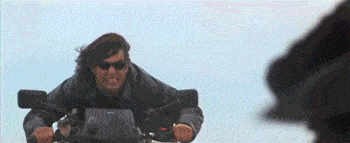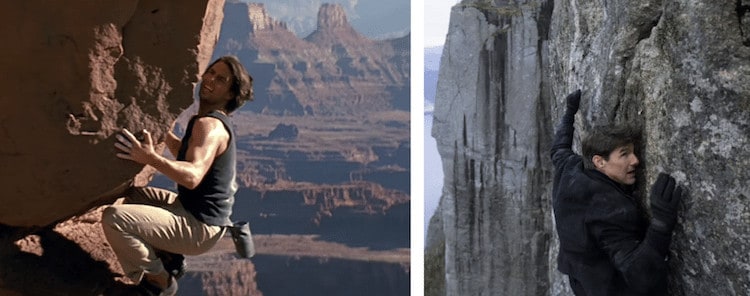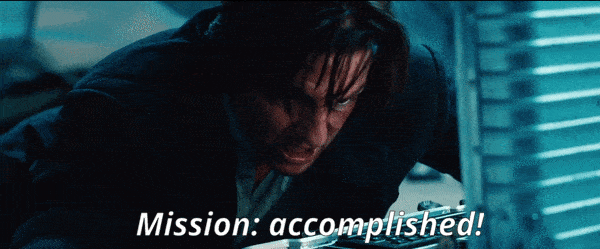How to Escalate a Franchise According to ‘Mission: Impossible — Fallout’
Mission: Impossible—Fallout shares a lot of beats with its predecessors. Why doesn’t it feel derivative?

Mission: Impossible — Fallout knows that it’s the sixth entry in a franchise. There are running jokes and established relationships; when Ethan reassures us that he’ll “make it work,” there’s no doubt in our minds that he will.
When a sequel echoes its predecessor too strongly it can feel lazy, or worse, condescending. It’s the disappointment of realizing you’re having a recurring dream or that you’ve unwittingly read the same paragraph five times. There’s rarely an exclamation mark at the end of “oh, this again.”
Fallout, perhaps more than any other Mission: Impossible film, feels familiar. And what’s fascinating is that that familiarity never feels derivative. And the way Mission: Impossible frames escalation has a lot to do with why these echoes don’t feel cheap. It’s not enough for Death Star 2.0 to be bigger; it has to pose a new challenge for our heroes rather than some half-assed, ambiguous “more.”
The joy of the Mission: Impossible franchise is watching Ethan Hunt tackle difficult, some might say impossible, challenges. We keep coming back because we love to see him presented with something familiar only wait, there’s a catch.
Below I’ve supplied some of those familiarities, and their accompanying catches. There are more, to be sure. But these are some of my favorites:
Can you feel that? It’s ‘Mission: Impossible – Fallout’ spoilers. They’re headed this way.
A likable, morally complex lady villain

From Mission: Impossible (1996)
While no more than a tertiary villain on paper, Max (Vanessa Redgrave) proved to be something far more liminal and interesting. She’s an arms dealer; the kind of byline we’d expect from a cut-and-dry baddie in a spy caper. But, at the same time, we can’t help but like Max. She’s a powerful businesswoman with a sense of humor and, like us, she’s charmed as shit by Ethan Hunt. Fallout‘s Alanna a.k.a White Widow (Vanessa Kirby) takes after her mother, and then some. She’s flirty, witty, respected, and her morals are muddier than the Seine. Like Max, she’s an arms dealer, but she’s also a philanthropist and a covert ally of the IMF and the CIA. In a franchise lousy with black-and-white “what if nuclear war is a good thing??” antagonists, gray-area villainy is welcome. Kudos to Fallout for doubling down on dubiously devilish dames.
Third act helicopter ballet

From Mission: Impossible (1996)
The first Mission Impossible takes itself pretty seriously. That is, until the third act in which a high-speed train is pursued by a helicopter through the Chunnel. For all the CGI wizardry late-90s ILM could muster, the set piece is fantastically goofy. Mission: Impossible’s next notable helicopter sequence, during the prologue of Mission: Impossible III, was a marked improvement from a technical perspective but lacked the pizzaz of its predecessor. Enter: Fallout’s helicopter ballet. All the audacity of the Chunnel chase with none of the goofiness because baby, they did it for realsies. What better way to up the ante: no CGI, no models, just Tom Cruise being willing to risk it all for a stunt.
Finale fisticuffs

From Mission: Impossible II (2000)
Recipe for success: put Ethan Hunt and the big bad in an enclosed area and let them punch each other in the face over a MacGuffin until Ethan inevitably wins. The climax of the John Woo fever dream better known as Mission: Impossible II, sees Ethan and Sean (Dougray Scott) throw down on a sandy cliffside. After winning, Ethan is picked up by his team and with the cure in hand, they rush to inoculate patient zero Nyah before she leaps to her death. Fallout takes Mission: Impossible II’s building blocks and weaves gold out of straw. The sandy cliff is swapped for a forbidding, jagged alpine slope. Woo’s dreamy slow-mo is exchanged for punches that land with threatening thuds. And, critically, neither party is in possession of the remote detonator, which is left skittering across the rocks.
Now I’m Freeeeee! Free Climbin’!
 From Mission: Impossible II (2000)
From Mission: Impossible II (2000)
People like to see Tom Cruise run. People like to see Tom Cruise jolt awake. And people like to watch Tom Cruise dangle off things. For all its faults, Mission: Impossible II was wise enough to capitalize on this and show Ethan Hunt scrambling all over a cliff face without any safety gear (to the dismay of John Woo). Fallout looked at the receipts and thought: you know what’s missing? More stakes. Elevating the action (quite literally), Fallout ups Ethan’s penchant for precarious clinging by dangling the man off a mountain, with a baddie on one end and a mission-critical remote detonator on the other.
Love interest bargaining chips

From Mission: Impossible III (2006)
It would have been so easy for Fallout to re-position Julia (Michelle Monaghan) as a damsel in distress; a human casualty of Ethan’s desire for normal life. This is, after all, the big bad threat of Mission Impossible III. Sure, Owen Davian (Philip Seymour Hoffman) is ostensibly after the lucrative-weapon-terrorists-want du jour, but his threat as an arms dealer is secondary to the threat he poses to Julia. Like plenty of superheroes, Ethan’s only weakness is the people he loves. And in Fallout, the vengeance-obsessed Solomon Lane (Sean Harris) aims to exploit that weakness, which culminates in everyone Ethan cares about (Julia included) being in the same soon-too-be-nuked Kashmiri medical camp. Only, Lane didn’t do his homework. Julia may have been in distress in Mission: Impossible III, but she wasn’t exactly helpless, holding her own against Davian’s thugs and resuscitating an electrocuted Ethan. In Fallout, Julia not only helps defuse a nuclear bomb (!!!), she looks guilt-riddled Ethan dead in the face and tells him that she’s never been happier. Hell yeah, come through character growth.
Last-minute bomb diffusing

From Mission: Impossible — Ghost Protocol (2011)
Alfred Hitchcock said it best: the secret to suspense is telling the audience that there’s a bomb, and never letting the bomb go off. The climax of Ghost Protocol sees Ethan Hunt and big bad Kurt Hendricks (Michael Nyqvist) rolling down a car park after a launch control device. Ethan’s team is elsewhere trying to bring the broadcast station back online. It’s super tense and the stakes (see: total annihilation of San Fransisco) are high. Last minute bomb diffusing is the kind of shtick Mission Impossible could easily get trapped in. How do you raise the stakes when your baseline is nuclear goddamn war? Well, for starters, in addition to irradiating a sizeable portion of the Earth’s drinking water, in Fallout, the nukes are a direct threat to people Ethan (and we, the audience) care about. To boot, Fallout breaks Hitchcock’s rule. Or, rather, we think it does. The blinding white light turns out to be a fake out but in those brief moments of “whaaaaa??” Fallout seems to deviate from its unspoken promise: the missions aren’t actually impossible. And for that one terrifying second, we thought this one might be.
The scope of international espionage

From Mission: Impossible — Rogue Nation (2015)
The scope and scale of Mission: Impossible has always been international. But the reach of espionage organizations like the IMF was always somewhat hazy. Then Rogue Nation brought MI6 into Mission: Impossible cannon. Turns out spy shit isn’t an American monopoly, baby. Fallout not only elaborates on the machinations of MI6 but clarifies the role of the CIA, hitherto an occasionally muttered alternative when the IMF got uppity. Here’s hoping the franchise continues to world build with other international groups. Is there a Canadian equivalent to the IMF? Do they assign missions via self-destructing roll-up the rim cups? I must know!
Guess we’ll have to wait for the next Mission to find out. Hang in there.

